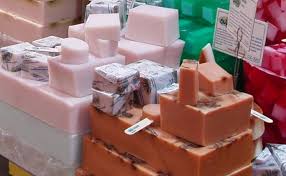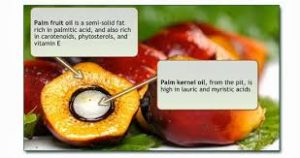This particular olive, coconut, palm kernel & less water recipe came about because of the Blackberry and Orange soap recipe. The finished bars were a little soft – usable, but a little softer compared to the other bars. It was concluded this was because of the huge amount of orange essential oil needed to obtain and decent long-lasting scent. The solution was to add a palm or palm kernel oil PLUS add a little less water, but not too much. The palm kernel oils help to make a harder bar and the less water due to the more liquid of the orange essential oil. And this worked perfectly!

The only oil to not use in over 50% of total oils, is canola oil. Although canola oil is the oil of every single restaurant on the planet, it isn’t the best for soap, but only because of the reaction to the lye and the oxidation of the oils. This means that a canola oil-based soap will start getting brown discolored spots on the soap bars. This is too bad really, because the cheaper cost of the canola helps keep the price of your final product lower. more about the type of oils and the pros and cons of each can be found on this basic soap-making recipe page.
This makes about 25 4-ounce bars, so dividing it in half to make test batches would work well.

olive, coconut, palm kernel & less water :
- 48 oz Olive/Canola blend oils
- 9.6 oz palm kernel oil
- 6.4 oz coconut oil
- 19.0 oz water
- 8.7 oz lye crystals
- for a total of 91.7 oz soap base
Directions for making soap
Before starting gather all the equipment and ingredients you will need for your soap
Mixing your ingredients:
- Put on your protective clothing, apron, safety goggles, gloves etc
- Measure your water and pour it into the container you will be using for your lye/water mix
- Measure out your lye (sodium hydroxide)
- Slowly add the lye to the water, stirring to be sure it mixes well. This should be done in a well-ventilated area as the fumes can be quite strong. This will only last for 15 seconds or so. Stir until the lye is completely dissolved in the water. It will heat up to about 180 degrees and can now be put aside to cool down.
- While the lye/water is cooling use a scale and measure each of your soap oils and put them into your stainless steel pot.
- Place this pot on your stove or hot plate and turn on low heat to approximately 130 degrees.
- Once the oils have heated to 130 degrees take off the stove or hot plate and let them cool down to about 100 degrees.
- When the lye/water mix and the oils are both cooled down to about 100 degrees they are ready to be mixed.
- Slowly add the lye/water mix to your soap oils and stir you can use a stick blender and hand mix. Mix the soap until it traces. This is when the soap begins to thicken; you can test this by using your spoon to drizzle the liquid into the pot. You will see a trace that stays on the surface of the soap mixture.
- Once the soap has traced this is the time to add your scent and color.
- Mix the scent and color in well
- Pour this mixture into the lined molds, cover it with a piece of cardboard or plastic, put it to bed (place a blanket over the soap mold), and let set for a day or two.
- Once it has sat for a day or two, remove the soap from the mold cut and put it out to cure for 4 to 6 weeks.
Here’s an Orange Spice soap recipe, you’ll see the need for the olive, coconut, palm & less water recipe due to the highest volume of essential oils.
#handmadesoap #naturalsoap #makingsoapnaturally #soapmaking #soapmaking #soaps #artisansoap #bathandbody #cpsoap #coldprocesssoap #etsy #soapbase #soapcrafter #soapmaker #soaping #soapcrafting #soaphandmade #soap #giftidea #christmas #barsoap #handmadesoap #natural #organic #skincare #coldprocess #soapsupplies #soaprecipes
© 2023, Tes. All rights reserved.